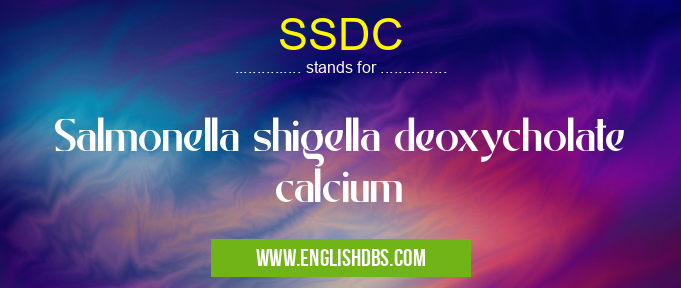What does SSDC mean in UNCLASSIFIED
SSDC stands for Salmonella Shigella Deoxycholate Calcium. It is a selective agar medium used for the isolation and differentiation of Salmonella spp. and Shigella spp. from clinical and non-clinical specimens.

SSDC meaning in Unclassified in Miscellaneous
SSDC mostly used in an acronym Unclassified in Category Miscellaneous that means Salmonella shigella deoxycholate calcium
Shorthand: SSDC,
Full Form: Salmonella shigella deoxycholate calcium
For more information of "Salmonella shigella deoxycholate calcium", see the section below.
Composition and Principle
SSDC agar contains ingredients that inhibit the growth of Gram-positive bacteria and promote the growth of Gram-negative bacteria, specifically Salmonella and Shigella. The medium contains the following components:
-
Nutrient agar
-
Sodium chloride
-
Lactose
-
Sucrose
-
Ferric citrate
-
Sodium deoxycholate
-
Calcium chloride
-
Sodium deoxycholate: Selectively inhibits Gram-positive bacteria.
-
Calcium chloride: Binds with deoxycholate, reducing its inhibitory effect on Salmonella and Shigella.
-
Lactose and sucrose: Serve as fermentable carbohydrates for differentiating Salmonella and Shigella based on their ability to ferment these sugars.
Procedure
Clinical or non-clinical specimens are streaked onto SSDC agar plates and incubated at 37°C for 18-24 hours.
Interpretation
- Salmonella spp.: Form dark red colonies with black centers due to the fermentation of both lactose and sucrose.
- Shigella spp.: Form colorless to translucent colonies due to the non-fermentation of both lactose and sucrose.
Advantages
- Selective for Salmonella and Shigella.
- Easy to use and interpret.
- Cost-effective.
Disadvantages
- May not be able to differentiate between all Salmonella and Shigella serovars.
- Can be inhibited by certain antibiotics.
Essential Questions and Answers on Salmonella shigella deoxycholate calcium in "MISCELLANEOUS»UNFILED"
What is SSDC?
SSDC (Salmonella Shigella Deoxycholate Calcium) is a selective agar medium used to isolate and differentiate Salmonella and Shigella species from other bacteria. It contains deoxycholate, which inhibits the growth of Gram-positive bacteria, and calcium, which helps to differentiate between Salmonella and Shigella species.
How is SSDC used?
SSDC agar plates are used to culture stool samples from patients suspected of having Salmonella or Shigella infections. The plates are incubated at 37°C for 18-24 hours, and the colonies that grow are examined for their characteristic appearance and biochemical properties.
What are the typical colony morphologies of Salmonella and Shigella on SSDC?
Salmonella colonies on SSDC are typically black or gray with a metallic sheen, while Shigella colonies are colorless or translucent. Salmonella colonies may also have a slightly rough or wrinkled texture, while Shigella colonies are smooth and glistening.
What are the biochemical tests used to differentiate Salmonella and Shigella on SSDC?
The biochemical tests used to differentiate Salmonella and Shigella on SSDC include the triple sugar iron (TSI) test, the lysine decarboxylase (LDC) test, and the urease test. Salmonella is typically TSI-positive, LDC-positive, and urease-negative, while Shigella is typically TSI-negative, LDC-negative, and urease-positive.
What are the limitations of SSDC?
SSDC is a selective medium, which means that it may not allow the growth of all Salmonella and Shigella species. Additionally, some other bacteria, such as Citrobacter and Klebsiella, may also grow on SSDC, which can make it difficult to differentiate these organisms from Salmonella and Shigella.
Final Words: SSDC agar is a valuable diagnostic tool for the isolation and differentiation of Salmonella and Shigella. Its selective properties allow for the targeted detection of these pathogens, aiding in the diagnosis and management of gastrointestinal infections.
